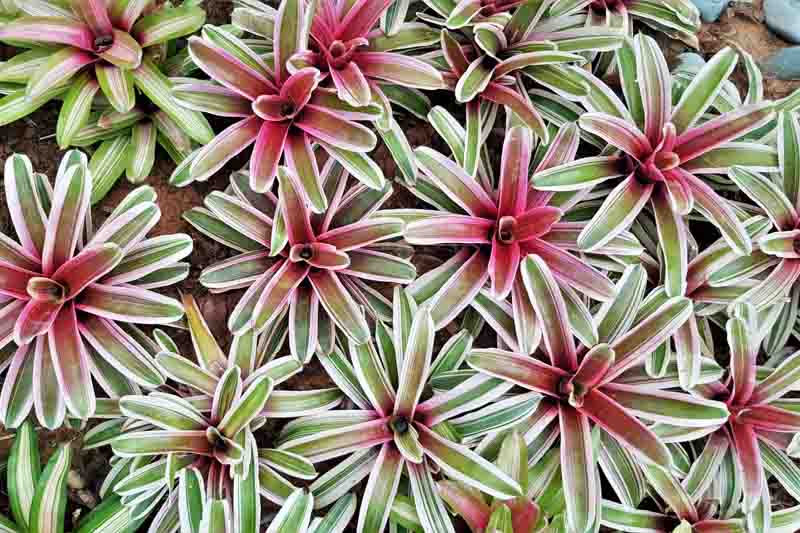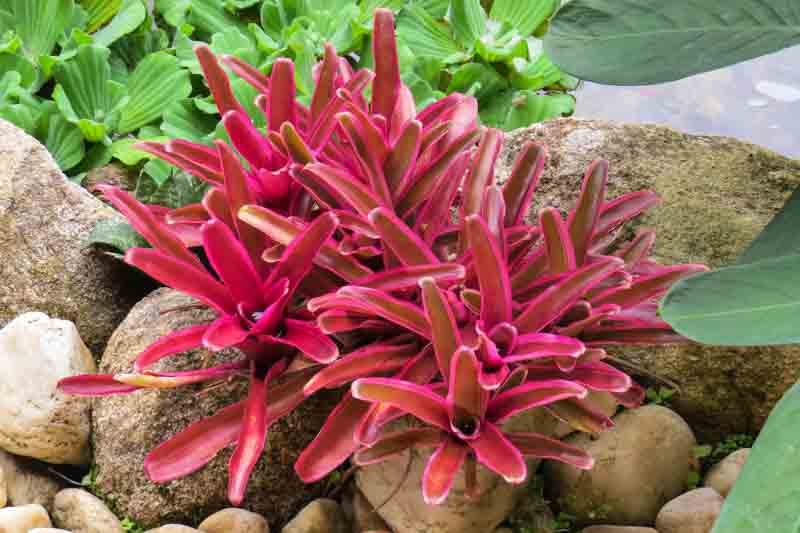Neoregelia, a stunning bromeliad, thrives as an indoor plant, making it a perfect, colorful addition to terrariums and indoor gardens.
Neoregelia is a genus of the bromeliad family (Bromeliaceae), prized for its stunning foliage rather than its flowers. The plants form a rosette of wide, flat leaves that often feature beautiful patterns, vibrant colors, and striking bands. The center of the rosette typically deepens in color as the plant prepares to bloom, creating a dramatic effect, hence the common name, Blushing Bromeliad.
Neoregelia includes over 100 species and numerous hybrids. Some well-known varieties include Neoregelia ‘Fireball’, cherished for its vivid red leaves, and Neoregelia carolinae, which displays bright green leaves with a red center.
Native: Neoregelias are native to the rainforests of South America, primarily found in countries like Brazil. They thrive in warm, humid environments, growing as epiphytes on trees. They absorb moisture and nutrients primarily through their leaves from the air and rainwater rather than through their roots, which are mainly used for anchoring to their growing support.
Growth Habit: Neoregelia are evergreen perennial plants. They have a compact, rosette-forming growth habit, with new rosettes (offsets) emerging from the base after the parent plant blooms. This clustering growth pattern can create dense, attractive groupings over time.
Size: The size of Neoregelia plants can vary significantly, with some species staying as small as 3 inches in diameter (7 cm), while others grow up to 2 feet across (60 cm). Their moderate growth rate allows for easy management in various settings.
Flowers: The flowers of Neoregelia are small, inconspicuous, and nestled deep within the rosette. They are typically blue or violet but are often overlooked in favor of the colorful foliage. Neoregelia bromeliads bloom once in their lifetime, focusing their energy on producing vibrant foliage. The parent plant typically dies after flowering, but the pups will continue its legacy.
Foliage: The foliage is the most striking feature of Neoregelia, with colors ranging from green, red, and purple to variegated patterns. The leaves are broad and can be glossy or matte, with smooth or spiny edges.
Hardiness: Neoregelia is hardy in USDA zones 10 to 11. In cooler climates, they are commonly grown as indoor plants or moved outdoors during the warmer months.
Uses: Neoregelia bromeliads are primarily used for ornamental purposes due to their vibrant foliage and compact growth. They are ideal for adding color to indoor spaces, terrariums, and shaded tropical gardens. They can also be mounted on trees or driftwood for a naturalistic display.
Toxicity: Neoregelia bromeliads are non-toxic to pets and humans, making them a safe choice for households with animals or children.
Key Fact: One fascinating aspect of Neoregelia care is the central vase formed by the rosette of leaves, which should be filled with water to mimic their natural habitat. This central reservoir helps provide humidity to the plant and can be a nesting spot for small beneficial insects in outdoor settings.

Neoregelia ‘Fireball’
Neoregelia bromeliads stand out in the plant world for several reasons, making them a special addition to any plant collection or garden. Here are the key aspects that make Neoregelias particularly unique and desirable:
Striking Foliage: Neoregelias are celebrated for their vibrant, colorful leaves rather than their flowers. The foliage can display a wide range of colors, including vivid pinks, deep purples, bright reds, and variegated patterns. This coloration often intensifies towards the center of the rosette as the plant prepares to bloom, creating a stunning visual effect.
Water-Holding Rosettes: The rosette structure of Neoregelias is designed to hold water, mimicking their natural rainforest habitat, where they often collect rainwater. This central “tank” provides the plant with a reservoir of moisture and nutrients and is a key aspect of their care.
Low Light Adaptation: Unlike many plants that require bright, direct light to thrive and show colors, Neoregelias are adapted to flourish under forest canopies, making them ideal for indoor environments with less natural light. Their ability to maintain vivid leaf coloration in lower light conditions sets them apart from other bromeliads.
Epiphytic and Terrestrial Growth: Neoregelias can grow both as epiphytes (on trees) and terrestrially (in soil). This versatility allows them to be used in a variety of gardening and decorative projects, from mounting on driftwood or bark to being planted in pots or directly in the ground in suitable climates.
Ease of Care: Neoregelias are relatively easy to care for despite their exotic appearance. They require minimal maintenance, making them suitable for gardeners of all skill levels.
Propagation through Offsets: Neoregelias produce offsets (also known as pups) after flowering, which can be separated and grown into new plants. This easy propagation method allows enthusiasts to expand their collection and share plants with friends and family.
Non-Toxicity: Neoregelias are not known to be toxic to pets or humans, making them a safe choice for households with animals and children. This peace of mind adds to their appeal as houseplants.
Decorative Versatility: Their compact size and striking appearance make Neoregelias versatile decorative plants. They can be used in various settings, including terrariums, tabletop arrangements, and as accent plants in shaded gardens.

| Hardiness |
10 - 11 |
|---|---|
| Plant Type | Houseplants, Perennials |
| Plant Family | Bromeliaceae |
| Exposure | Full Sun, Partial Sun |
| Season of Interest |
Spring (Early, Mid, Late) Summer (Early, Mid, Late) Fall Winter |
| Height |
2" - 1' (5cm - 30cm) |
| Spread |
3" - 2' (8cm - 60cm) |
| Maintenance | Low |
| Water Needs | Average |
| Soil Type | Loam |
| Soil pH | Acid, Neutral |
| Soil Drainage | Well-Drained |
| Characteristics | Showy, Evergreen |
| Tolerance | Dry Soil |
| Landscaping Ideas | Patio And Containers |
| Hardiness |
10 - 11 |
|---|---|
| Plant Type | Houseplants, Perennials |
| Plant Family | Bromeliaceae |
| Exposure | Full Sun, Partial Sun |
| Season of Interest |
Spring (Early, Mid, Late) Summer (Early, Mid, Late) Fall Winter |
| Height |
2" - 1' (5cm - 30cm) |
| Spread |
3" - 2' (8cm - 60cm) |
| Maintenance | Low |
| Water Needs | Average |
| Soil Type | Loam |
| Soil pH | Acid, Neutral |
| Soil Drainage | Well-Drained |
| Characteristics | Showy, Evergreen |
| Tolerance | Dry Soil |
| Landscaping Ideas | Patio And Containers |
Create a membership account to save your garden designs and to view them on any device.
Becoming a contributing member of Gardenia is easy and can be done in just a few minutes. If you provide us with your name, email address and the payment of a modest $25 annual membership fee, you will become a full member, enabling you to design and save up to 25 of your garden design ideas.
Join now and start creating your dream garden!
Create a membership account to save your garden designs and to view them on any device.
Becoming a contributing member of Gardenia is easy and can be done in just a few minutes. If you provide us with your name, email address and the payment of a modest $25 annual membership fee, you will become a full member, enabling you to design and save up to 25 of your garden design ideas.
Join now and start creating your dream garden!